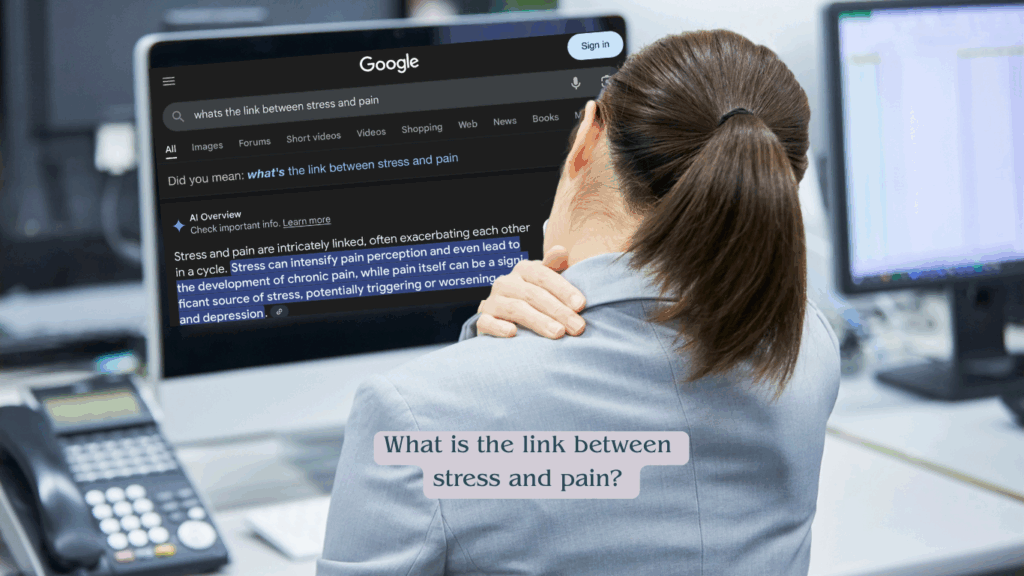Back to Wellness HubWellness HubBack PainChronic fatigueFibromyalgiaHeadachesHip and knee painNeck and shoulder painPain
If you’re living with persistent pain, you might have found yourself asking:
“Why is this pain still here?”
“Nothing showed up on my scans—so what’s going on?”
“My doctor tells me I have a structural issue, but they don’t have a solution to help me”
“Is this just in my head?” (Spoiler: no, it’s in your nervous system—but it’s very real.)
“Pain medications don’t seem to be working and I don’t know why”
“Do I have to live with this pain?”
Many people I work with have pain that didn’t start with a clear injury—or it did, but the pain stuck around long after the body healed (longer than 3 months). This type of pain often turns out to be neuroplastic pain—and the good news is, it’s treatable, but not with the classical bio-medical approach!
🧠 What Is Neuroplastic Pain?
Neuroplastic pain (sometimes called “mindbody pain” or “central sensitisation”) happens when the brain and nervous system become overprotective. Pain is a protective mechanism of the body along with inflammation. When body feels under threat it produces pain. Over time, we can get stuck in a fear-pain loop—sending pain signals even when there’s no ongoing injury or tissue damage.
It’s real pain, but it’s being generated by a sensitised nervous system, not by something broken in your body.
✅ The FIT Criteria: A Self-Check Tool
Dr. Howard Schubiner—one of the leading voices in neuroplastic pain—offers a simple way to tell whether your pain might be neuroplastic. It’s called the FIT Criteria:
🔹 F –
Functional
Did your symptoms start with no obvious injury or have they continued beyond a normal healing time frame (3 months)?
Are your symptoms symmetrical for example it hurts in one ankle and then the other ankle?
Do your symptoms occur down one side of your body?
Do you have symptoms in many different locations at the same time?
Symptoms have a quality of tingling, electric, burning, numb, hot or cold.
Have scans or medical tests come back clear—or not fully explaining the pain?
🔹 I –
Inconsistency
Symptoms shift from one location in the body to another.
Intensity of symptoms change depending on time of day or occur first thing in the morning or in the middle of the night.
Symptoms occur after, but not during activity or exercise.
Symptoms occur when you think about them or when someone asks you.
Stress can intensify symptoms.
Symtoms reduce or disappear when on holiday or engaging in joyful activities.
Therapy such as massage, craniosacral therapy, acupuncture, reiki etc can reduce symptoms but this relief is not long lasting.
🔹 T –
Triggered
Pain is triggered by things unrelated to the symptom such as foods, smells, sounds, light, computer screens, menses and a change in weather.
Symptoms are triggered by the anticipation of stress such as before school/ work, doctors visit, visit to a relative, social gathering.
Symptoms can be triggered simply by imagining these events or imaging a movement that causes pain.
Is your pain linked to emotions, stress, memories, or fear?
Do you notice flare-ups around certain people, places, or situations?
These are common signs that the pain is being driven by the brain’s “danger system,” not just the body. Your brain is trying to protect you—even if the threat isn’t physical.
If you’ve been told “everything looks normal” or “there’s nothing seriously wrong,” but you’re still in pain, it could be neuroplastic in nature. Similarly, if treatments like physio, surgery, or medication haven’t helped, this may be a clue.Neuroplastic pain often isn’t consistent like structural pain. It may come and go, or shift from one area to another. You might notice that pain worsens with stress or emotional tension, and eases when you’re relaxed or distracted.
🚩 What About Red Flags? When to Seek Medical Help First
Before assuming your pain is neuroplastic, it’s important to rule out serious medical issues. Here are some red flag symptoms that need urgent attention:
-
Cauda equina syndrome (a medical emergency):
-
Loss of bowel or bladder control
-
Numbness around the saddle area (genitals, buttocks, inner thighs)
-
Sudden, severe lower back pain with leg weakness
-
Unexplained weight loss, fevers, or night sweats
-
Numbness or tingling that is spreading rapidly
-
Pain after trauma or injury, especially in older adults
-
Persistent pain with a history of cancer
If you’re experiencing any of these, see your GP or go to A&E as appropriate. It’s always better to be safe.
🌿 What If You DO Have Neuroplastic Pain?
Here’s the good news: neuroplastic pain responds beautifully to nervous system retraining. That’s what my BEAT Pain approach is designed to support.
We don’t just chase symptoms—we work with the brain and body to help you feel safe, calm, and confident again. That includes:
-
Brain – understanding and retraining pain pathways
-
Energy – supporting your body’s healing with quality rest and good food
-
Activity – gentle, safe movement to rebuild trust
-
Therapy – tools to calm the nervous system and release stored tension
💬 Final Thoughts
If your pain meets the FIT criteria and you’ve ruled out red flags, there’s a good chance your body is protecting you a little too hard—and it’s time to gently retrain that system.
Please book a FREE consultation so that we can truly work out whether the BEAT pain approach is right for you.
FREE consultation












